Podcast: Play in new window | Download
Subscribe: Apple Podcasts | Spotify | Email | TuneIn | RSS
Sometimes we need to get away in order to heal, to take ourselves out of the routine and recognize how short life is, and how precious.
In this episode, Dr Karen Wyatt explains how travel helped her face grief and embrace living well in the face of death.
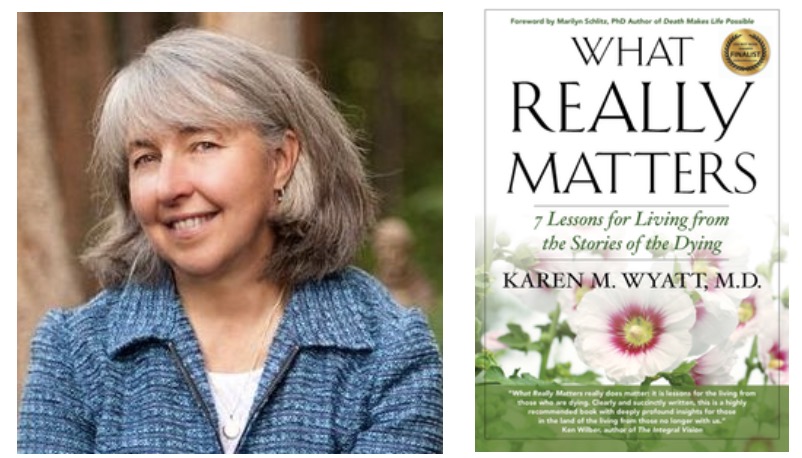
Show notes
- The personal loss that inspired Karen’s grief travels to Italy, Spain and France
- How traveling can help you realize that you are not alone in grief
- Why Herculaneum in Italy is such a powerful place
- Pere Lachaise cemetery in Paris
- The difference between cemeteries and death culture in Europe vs the USA
- Depictions of death in places of faith, and the European tradition of ossuaries and displaying bones publicly
- Why memento mori and being aware of the shortness of life helps us to live more joyfully
- Book recommendations for grief travel
You can find Karen at www.karenwyattmd.com and her podcast at www.eoluniversity.com, and on Instagram @kwyattmd
Transcript of interview with Dr Karen Wyatt
Joanna: Dr Karen Wyatt is a hospice physician and best-selling author of books about death, loss, and grief. She’s the host of the ‘End-of-Life University’ podcast and an inspirational speaker who teaches how to live a life that really matters, by embracing our mortality. And today, we’re talking about how travel, in particular, can help with grief and reflection on our mortality. So welcome to the show, Karen.
Karen: Thank you so much, Joanna. I am delighted to have a chance to talk with you today.
Joanna: Oh, I’m so excited. And I think we’re friends now, we talk about death together. So that’s cool. So today, I wanted to talk about your grief trips, which you call them.
So you’ve been to Italy, France, and Spain on grief trips. Tell us what prompted these journeys and why you decided that travel might help.
Karen: Well, my first grief trip was actually inadvertent in a way. It was a trip to Italy my husband and I had planned, but the morning we were leaving for our trip, a patient of mine died, a young patient died of the H1N1 flu. It was back during that flu epidemic. So I left on that trip feeling a great deal of grief, having lost a patient. And I really didn’t even want to go, I thought the trip would be a disaster because I was so sad and carrying so much grief.
And yet, I got to Italy and, everywhere we went, I found comfort because I was just learning so much about grief and death and how it has shaped history really and culture and art. And so, everywhere I went, I actually felt comforted on that trip. And that’s when my eyes were opened that travel can be a really powerful way of facing our grief and actually dealing with it.
Travel can be a powerful way of facing our grief and actually dealing with it.Click To TweetJoanna: Well, it’s interesting because so much of Europe is about history, and people come here and travel and look at places built by dead people basically. So I wanted to ask particularly, you went to Normandy tracing your dad’s footsteps, so tell us about that because that’s quite different to the patient who died.
Karen: Yes. Well, my dad died, now it’s been 30 years ago, of suicide. And I’ve spent many years trying to understand his suicide and trying to figure out the roots of it.
And I realized, he served in World War II and was part of the Battle of Normandy, landed on the beach of Normandy. And I realized that had a lot to do with some of the depression that he had experienced his whole life because of the trauma of war.
So I really wanted to visit Normandy myself and just see what it was like. And an amazing thing happened that we signed on to a tour and had a young French woman as our guide who took us out to the beach and to the American Cemetery. And I shared with her what division my father served in, in the U.S. Army, and she showed me a map where we could discover where his division landed, what day they landed, and then, what battles they participated in after they landed at Normandy.
It turned out my father’s division fought in the Battle of Saint-Lo, the village of Saint-Lo. And the guide was speechless for a moment and got tears in her eyes and she said, ‘I’m from Saint-Lo,’ and she said, ‘My family has lived there for generations.’ And she turned to me and she said, ‘I am so grateful to your father for serving in this war because I wouldn’t be here today if it weren’t for those soldiers who fought in that battle.’
Suddenly, like it was this moment of such healing because I realized all the grief and guilt my dad felt about participating in war and taking lives of other people, it just came full circle because here was a young woman who might not be here today if it hadn’t been for that battle. She and I just bonded in that moment, with that connection between us. And so, for me, nothing could’ve been more powerful in terms of healing my own grief, helping me understand my dad, and then, even feeling like this was healing for my dad, you know, for what he left behind of pain and sorrow from the war.
Joanna: Wow, that’s incredible. And I mean did your dad ever go back there?
Karen: He did go back, he and my mom went back. And I think I was in college, at the time, and I didn’t quite…at that time, I didn’t understand the impact the war had on him. So he was stationed in England, and he visited England and France to retrace some of his own steps. But I don’t know for him, I don’t know if that was a healing experience or not because I wasn’t really connected or even thinking about any of these things at that age.
Joanna: Wow. And it’s so interesting you mentioned these European war fields because, as schoolchildren, here in Britain, they take us, when we’re kind of aged 14, 15, they take us to the battlefields of World War I.
Probably the first time I ever felt massively impacted by death was going to the Somme and going to those battlefields and realizing the scale of death. So it’s so interesting that you would go back there.
Do you feel like it helped your grief for your father? Why is travel helpful for grief?
Karen: For me, I think what was helpful is that I started to recognize that my grief is not a solitary experience, that this is part of the human condition, that everyone grieves.
It was eye-opening for me. I mean that seems obvious, in some ways, and yet, in the midst of pain, I had been feeling so alone and isolated. By just traveling and seeing places where tragedies have happened, and seeing memorials, and how people remember their dead, it made me feel connected in such a larger way and it eased my grief to know that I’m not alone at all.
Everyone experiences this. And for the first time, I actually felt like, ‘Oh, now I really know what it means to be a human. I’m part of humanity now because I’m experiencing the depths of loss but I’m also experiencing the creativity that can come from loss and grief and pain.’
Joanna: You and I have talked about death before, I’ve been on your End-of-Life podcast and you’ve been on my podcast talking about writing about death as well before, and I wonder whether you also, like me, feel a sense of something when you’re in a place where there has been such death.
Obviously, people die everywhere all the time, but there are these places, I feel, in the world, where there’s almost the land itself has changed because of this occasion. And it just feels different.
Do you have that sense of place when you travel?
Karen: Yes, absolutely. I actually seek out cemeteries when I go to new places. Even if I’m driving through some small town and I see the cemetery, off to the side of the road, I seek it out because I feel like, suddenly, I know a little bit of the history of that place and I feel connected, wherever I go.
Joanna: Absolutely. And I also follow your Instagram channel and I think you follow mine as well, we share our pictures. You visited Herculaneum in Italy, which I think is incredible. It’s this whole city, if people don’t know, a whole city buried by lava and ash.
It was by the eruption of Mount Vesuvius, we should say, nearly 2,000 years ago. So this is not like World War I or World War II, this is a long time ago. But it was buried so quickly and there are still skeletons crowded under the arches of the city, people who tried to shelter.
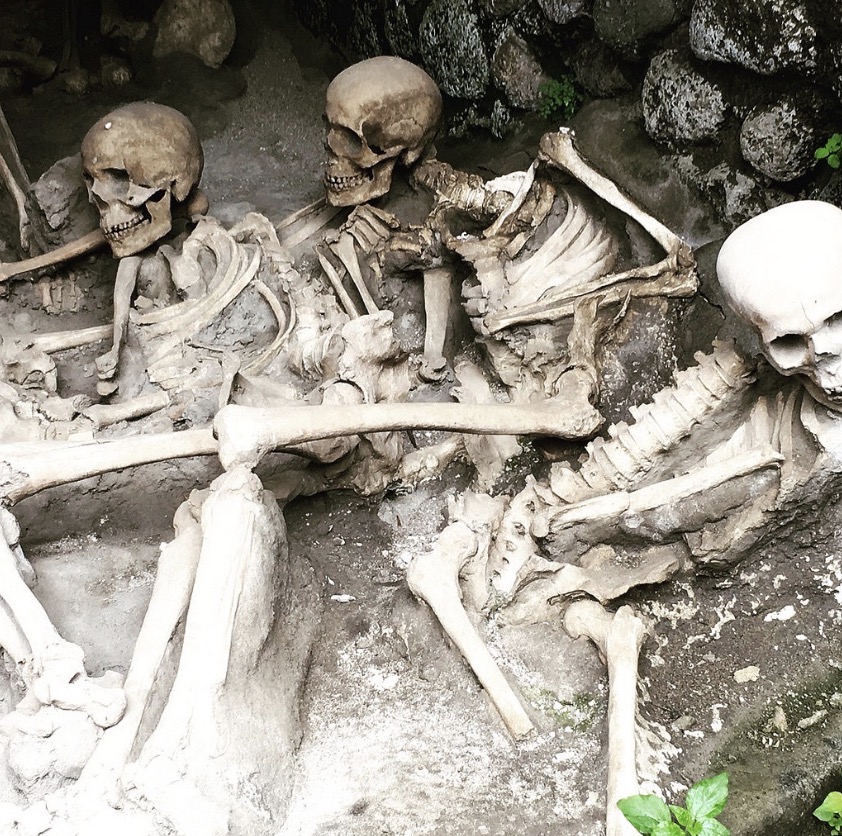
We have exactly the same picture on Instagram of the skeletons. So I wondered like what were your thoughts there, in Herculaneum, where that death was so long ago, and yet, it feels so sudden?
Karen: It was so powerful, seeing the skeletons in the place where those people died, where they were huddled together hoping for safety, I spent a long time there just contemplating it because it was so profound.
And you could feel, in some ways, their fear, the terror of the situation they were in, but I also had a sense of love because you could see one skeleton looked like an adult holding a child. That was just powerful for me to think that, in these last moments of life, they were huddled together, connected together, experiencing love together in their last moments of life.
It’s so profound, it’s really hard to describe, in a way, the feeling that you have taking this in and recognizing these are the remains of the people who actually died here that many years ago.
Joanna: And as you say about the human condition, it reminds you, I think, that, 2,000 years ago, people were still the same. What’s so interesting about Herculaneum is they have a taverna where you could’ve had a drink, there was a little restaurant where you could’ve gone to get your dinner. You know, there was the swimming pool, there was the hotel. It was no different except for our technology, I guess.
Karen: Yes. And after we visited there, we went to Sorrento, the modern-day town of Sorrento, but we were in the older part of town. And here, it looks exactly the same, there are little shops, there’s a little tavern, there’s a little restaurant on the corner where you can get soup, and the narrow streets. It felt exactly the same, like people are still living in these same places.
Joanna: One of the other things you and I both enjoy is going to cemeteries. And you mentioned that you would stop by the side of the road and check one out. And I’m the same when I do visit sort of the big cemeteries, too. And we’ve both been to Pere-Lachaise, in Paris.
What particularly struck you about Pere-Lachaise?
Karen: Well, first of all, how massive it is. It’s so huge. It’s easy to get lost in the midst of that cemetery, it’s such a maze in some places, but that was wonderful actually to spend a few hours just lost and wandering through it.
Also, I noticed the juxtaposition. In one part, there would be a relatively recent grave that still was, you know, being decorated regularly with fresh flowers, and then, nearby, a gravesite with perhaps a mausoleum or headstones that were, you know, 150 years old that were crumbling now and falling apart. Some of the graves are well tended because there are still people alive who remember this person, but some of the graves are so old there’s no one any longer who cares for them.
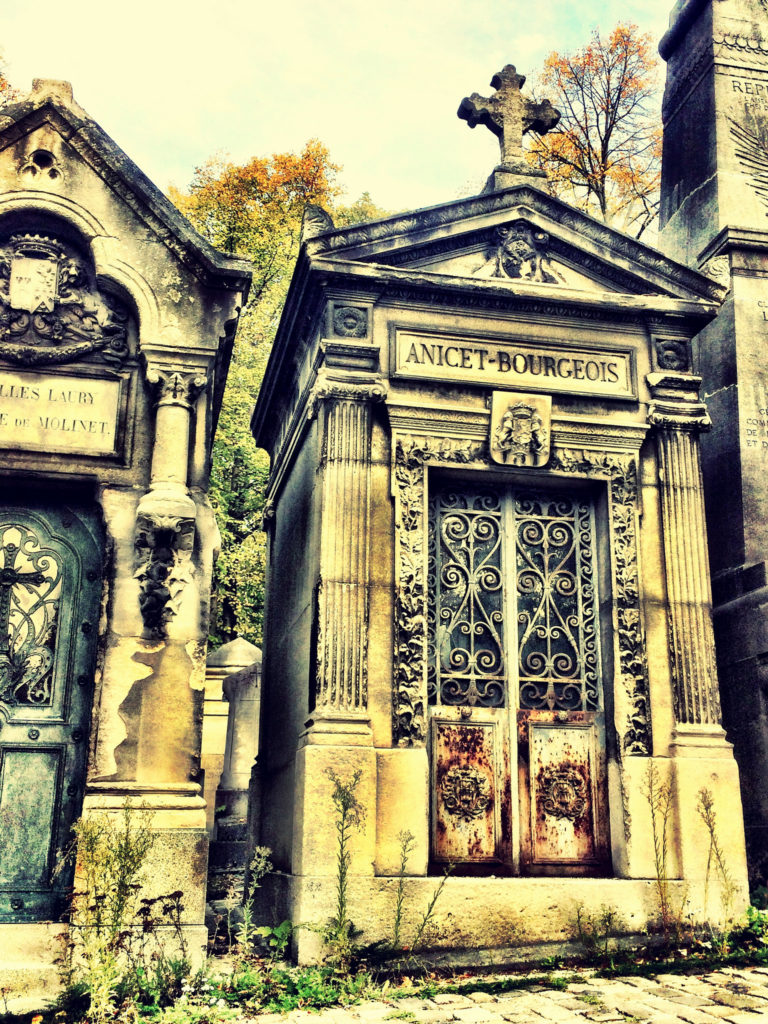
It just reminded me of impermanence, you know, even when we try to build these mausoleums or headstones to remember our loved ones, everything crumbles eventually in the end.
Joanna: What do you think about the difference between the European cemeteries and what you’re used to in America?
Karen: I guess I feel like here, in the U.S., death is really sanitized so much more. And so, it seems as if it’s all been orchestrated to keep it as far away from us as possible, and so, to make the cemetery look perfect and orderly when death is not orderly at all.
In Italy in particular, death is made visible, and grief and mourning are made visible, whereas here I feel like we struggle to keep it hidden as much as possible so that we don’t have to feel the sorrow or feel any discomfort with it.
Joanna: I’ve been to a few graveyards and cemeteries, in the U.S., and like you say, I do feel like they are more sanitized, even if they’re historical.
Karen: Well, somewhat. Although visiting the American Cemetery, in France, at Normandy, was really profound. And one thing that strikes you is these rows and rows of crosses, and then, also the Stars of David lined up in perfect rows.
But there’s something really beautiful and sacred about that orderliness and it doesn’t feel at all that it’s trying to hide the grief, it almost feels like it’s part of the memorial of the place, is that everything is lined up so perfectly in that cemetery. And here I guess we do have that same effect in military cemeteries, of everything being orderly. But there’s something about the location of the cemetery, in France, like being with a view, over the ocean, and the statues that were nearby. All of the reminders of war. It felt like it wasn’t hiding from the fact that these soldiers all died in the war.
Joanna: You mentioned faith there, the crosses and the Stars of David. Both of us have also visited lots of Catholic cathedrals, particularly around Spain, and Italy, and also in France. And often these places have particularly bloody images of crucified Christ or martyred Saints.
I was looking at your pictures of Granada in Spain, and the Capella Real, I don’t if you remember, has these gruesome martyred saints, one being boiled alive and another beheaded.
What are your thoughts on the depiction of death in a place of faith?
Karen: Well, that was one of the biggest shocks for me the first time I ever traveled to Europe, which was Italy the first time, and seeing relics, seeing bones, and skeletons, and these, as you said, more gruesome images of death really surprised me because I had never seen that in the churches, at least that I have been in here, in the U.S., in my life. And so, it also showed me that our churches, like our cemeteries, are, in some ways, taking a step back away from death and really protecting us from those images, in a way, when it was very profound to see how graphic some of the images are in the European churches.
Joanna: Yes, it is so interesting, although I think I said to you, there’s a church in Pittsburgh (St Anthony’s Chapel) with the most relics in the world outside of the Vatican.
Karen: Oh really? No, I haven’t been there, so I didn’t realize that.
Joanna: I’m pretty obsessed with relics, and I’m not a Catholic. I have great respect for people of faith, I don’t have any particular faith, but I am obsessed with holy relics.
Did you see anything really weird or that made you go, ‘Whoa,’ that’s totally unexpected or surprising?
Karen: One surprise was in Otranto, Italy, in Puglia, down on the Adriatic coast.
We were on a bike trip through Puglia, so I wasn’t necessarily like looking for death necessarily on that trip. We stopped for lunch in Otranto and we went to see the cathedral of Otranto because it has this famous mosaic floor, in the church, that was created by one monk like, oh, 1,000 years ago or so.

He laid all these tiles of the Tree of Life on the floor. So we went there to see the mosaic, the floor mosaic, but then discovered there’s a chapel attached to that cathedral that has the bones of 800 Christians who were martyred by the Ottomans.
They have huge cases, behind the altar of the chapel, that contain the bones of all these martyrs. I’d never seen anything like that before, so many bones displayed in this holy sacred cathedral. So that was a real surprise. That day, we weren’t looking for it and I hadn’t even heard of that place before.
Joanna: Did you get to the Paris catacombs?
Karen: No, I haven’t. I didn’t have time to go there, so that’s a place on my list that I need to go back to.
Joanna: Oh, you totally do. I like catacombs and ossuaries. I think the physical depiction of death helps me with memento mori, remembering we will die.
But I also wanted to point out that you also have nice pictures of you and your husband drinking wine in the sun, being happy. You and I are both positive people too.
Maybe you could talk more about why is it good to be aware of the shortness of life and what really matters?
Karen: Well, it’s interesting because actually, before my dad’s death and before I started exploring death, I realized I was a more serious person and I feel like I carried the weight of the world in a really heavy way. I found it hard to be joyful. That got worse, of course, when I was grieving over my dad’s death.
But it was really through working in hospice with dying patients, and then, exploring death and getting comfortable with death, that I found my way back to being joyful again.
It’s what you were describing, like ‘Wait a minute, I’m only here for a short time. My life is short. Yes, there might be suffering and sorrow during this life, but there’s abundant joy and pleasure in the world, too, and love. So, I don’t want to miss a moment, I don’t want to spend a moment of my time not experiencing the joys that are here.’
So, I really think exploring the grief and the pain of death is what opened me to finally recognize it’s okay to love being here, even when times are sad, even when something goes wrong. It’s okay to celebrate that and really enjoy life.
Many of my hospice patients demonstrated that to me because I found people on their death beds, in the last few weeks of life, who were telling me like, ‘This is actually the most I’ve ever loved being alive. I love it right now because I know it’s short, I know I don’t have that much time, but I wish I had lived this way my whole life.’
That example reminded me that’s how I wanna be living every day right now, recognizing like…I don’t know how long I’ll be here so I’m going to make the most of this moment today and get everything I can out of it. And that has really, really shaped my travel experiences, too.
Joanna: That’s fantastic. Tell us a bit about the book that you’ve written particularly around this area, What Really Matters: 7 Lessons for Living from the Stories of the Dying .
Karen: Well, after my years of working in hospice and sitting with patients at the end of life, I really felt like it transformed me spiritually, in a way, and how I lived my life on a day-to-day basis, the lessons that I learned from my patients.
One of my patients said to me, ‘I only just now figured out what really matters in life. And yet, I won’t even be here two weeks from now. And I just now learned this.’ And he said, ‘I wish I could tell other people the story so they could learn it earlier.’
That stuck in my head, what really matters, what really matters. And then, I ended up writing this book which has stories of hospice patients and their families that I worked with, especially those who had really profound transformations at the end of life, and then, the lessons that I learned about how to live life through their experiences.
Joanna: That’s fantastic. Are there any other books that you might recommend people read about grief or travel that you’ve particularly enjoyed?
Karen: One book that I enjoyed was Wild by Cheryl Strayed, which is the story of her, she hiked over 1,000 miles on the Pacific Crest Trail after her mother died. Her mother died, her marriage fell apart, and she was just feeling lost. But she used that hike and kept extensive journals on her hike and used it to explore her grief. And I really enjoyed reading that book.
Another book that’s really interesting for travel, to inspire travel, is the book From Here to Eternity: Traveling the World to Find the Good Death by Caitlin Doughty. I don’t know if you’ve heard of that book.
Joanna: Oh,that’s a great book. I really want to get her on this show.
Karen: You’d love talking to her. It’s a great book. It’s actually given me some places that I wanna visit now after reading about her travels there.
Joanna: I loved ‘Wild’ as well, that’s really fantastic.
So if people can’t travel due to health, or can’t afford to travel, how can we change our attitude to noticing the world?
Are there ways we could do a grief trip in our own community?
Karen: Well, I mean I think you can explore your own community because there’s obviously like signs of death and grief everywhere, so, visiting cemeteries in your own community and just being aware of what’s happening in the community.
But one thing I’ve learned so much from is like watching The History Channel, either watching documentaries or reading some of their articles online and really learning about history. That’s been powerful for me because so much of our history is all about war and tragedy and death and grief. I think you can do a lot to just expose yourself to information.
Then, I encourage people to not shy away from death but actually to intentionally start to think about it every day, like to start thinking about the fact that, ‘Oh, I’m here today but I don’t know how many days I have,’ to just allow those thoughts to come to mind.
For some people I even recommend becoming a volunteer in hospice because it gives you a chance to, like I did, to sit with the dying and learn about death from people who are actually going through it.
Joanna: I have a Mexican sugar skull on my desk — it’s a skull but it’s also covered in butterflies.
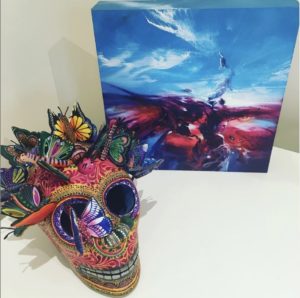
Mexican Day of the Dead is probably top of my list for what I would call death travel. So I wondered about you, given the shortness of life, what’s on your list for your travels next?
Karen: I also want to visit Mexico, I’ve never been to the Day of the Dead. And I’m actually fairly close here where I live, so that would be a short trip for me. I’d like to visit I guess more World War II sites where my dad was, in Belgium and Ardennes. I don’t know if I’m pronouncing that correctly, in France, and then, also in England because he was stationed in England for quite a while, too, before Normandy. So I’d like to visit those sites. And then, the Czech Republic because I’m attracted to the Bone Church there, I know you visited.
Joanna: Yes, Sedlec was amazing. Where can people find you and your books and your podcast online?
Karen: Well, my personal website is www.karenwyattmd.com. My podcast though is called ‘End-of-Life University’ podcast, and then, I have a website for that, www.eoluniversity.com.
Joanna: Brilliant. Well, thanks so much for your time, Karen. That was great.
Karen: Thank you, Joanna.

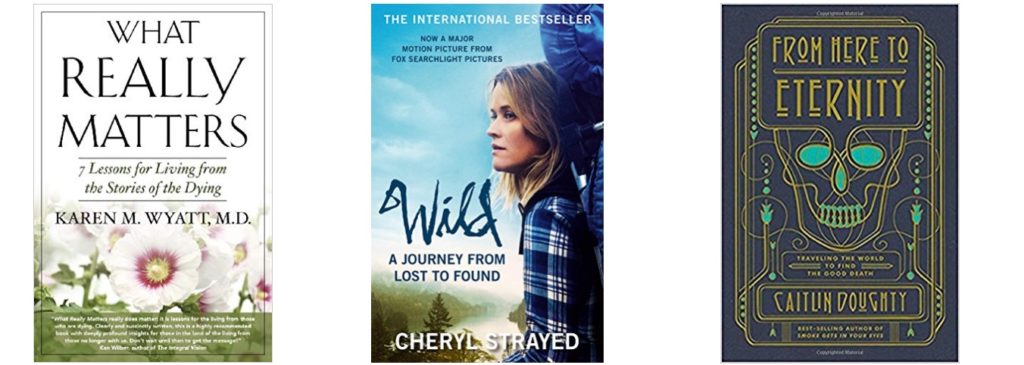
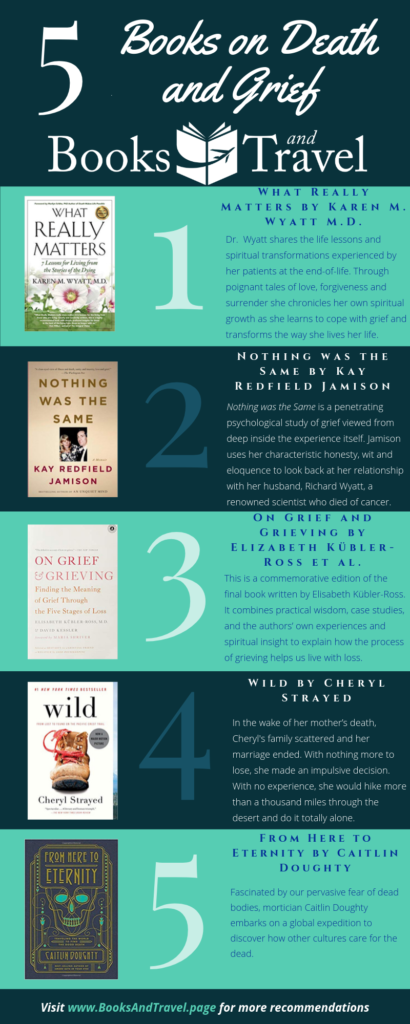
Patzcuaro & Mexico City for Day of the Dead are certainly worth a visit. Also the Tana Toraja Region of Sulawesi- I must dig out my photos….
Thanks for another really inspiring episode. I agree travelling helps with grief and coming to terms with our own mortality. When I take myself away from the mundane routine of life, travelling very much is like opening a book — I know I’m going to learn something and be amazed. Travelling helps me process my fears (all of which can be sourced to my fear of death) and to think about things that matter.
I have signed up to Dr Karen Wyatt’s podcast – thank you for the introduction.
I loved this episode because the parallels with some of my own travel were quite spooky! It brought back many happy memories of Herculaneum – when we were in the harbour area looking at the skeletons, the frogs in the nearby bullrushes were making lots of noise – evidence of life alongside the tragic deaths. I found it much more personal and intimate than Pompeii, which is more about status and grandeur. One house had part of the first floor intact, including a bed frame with a bedpost which was quite poignant – those little details made it very atmospheric.
We also went to Otranto in Puglia, last September, which we loved – that mosaic floor in the cathedral was certainly impressive, along with the bones of the martyrs.
I’ve also enjoyed Cheryl Strayed’s ‘Wild’ – what a journey she went through, both physically and mentally.
Jo, you might remember I sent you photos of the Mappa Mundi and Catalan Atlas when we were in Las Palmas, Gran Canaria, knowing you were working on Map of Shadows. In the same place (Casa de Colon), there were also cases full of skulls. I’ll send you a photo via your JF Penn Twitter account.
I’m loving this podcast – there is so much variety and I share your twin passions of books and travel. We’re off to Santorini next month then Japan in late Sept/early October. Can’t wait!
Thanks for the escapism!
Julie x
Thanks, Julie 🙂 and it sounds like you have some fantastic travels under your belt, with more to come. Japan is also on my list – just waiting to plan it more. I’d definitely like to set a book there!